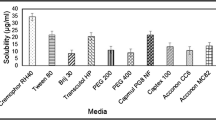Purpose
These studies evaluated the ability of common household food and drink products to mask the bitter taste of three selected anti-terrorism drugs.
Methods
Three anti-terrorism drugs (doxycycline, ciprofloxacin hydrochloride, and potassium iodide) were mixed with a variety of common household food and drinks, and healthy adult volunteers evaluated the resulting taste and aftertaste. In parallel, the ASTREE Electronic Tongue was used to evaluate taste combinations. Stability of the mixtures over time was monitored, as was the dosage uniformity across preparations.
Results
Foods and drinks were identified that satisfactorily masked the bitter flavor of each drug. Dose uniformity and stability were also acceptable over the range studied, although some combinations were significantly less stable than others. The electronic tongue was able to differentiate between tastes, but ranked masking agents in a different order than human volunteers.
Conclusions
Doxycycline, potassium iodide, and ciprofloxacin, which are stockpiled in solid tablet form, can conveniently be prepared into more palatable formulations, using common household foods and drinks. The electronic tongue can be used to perform an initial screening for palatability.
Similar content being viewed by others
Abbreviations
- ATW:
-
average tablet weight
- DI:
-
discrimination index
- Cipro:
-
ciprofloxacin hydrochloride
- FDA:
-
Food and Drug Administration
- GLM:
-
general linear models
- KI:
-
potassium iodide
- PCA:
-
principle component analysis
- RSD:
-
relative standard deviation
- USP:
-
United States Pharmacopeia
References
How to Prepare Emergency Dosages of Doxycycline at Home for Infants and Children, http://www.fda.gov/cder/drug/infopage/penG_doxy/doxycyclinePeds.htm (accessed 03/01/05), and Home Preparation Procedure for Emergency Administration of Potassium Iodide Tablets to Infants and Small Children, http://www.fda.gov/cder/drugprepare/kiprep.htm (accessed 03/01/05).
USP 24, United States Pharmacopeial Convention, 2000.
USP 25, United States Pharmacopeial Convention, 2002.
R. W. Steele M. P. Thomas R. E. Begue (2001) ArticleTitleCompliance issues related to the selection of antibiotic suspensions for children Pediatr. Infect. Dis. J. 20 1–5 Occurrence Handle11176558
J. Cohen (1988) Statistical Power Analysis for the Behavioral Sciences, Chapter 8 Lawrence Erlbaum Hillsdale, NJ 273–403
M. E. Ruff D. A. Schotik J. W. Bass J. M. Vincent (1991) ArticleTitleAntimicrobial drug suspensions: a blind comparison of taste of fourteen common pediatric drugs Pediatr. Infect. Dis. J. 10 30–33 Occurrence Handle2003053
D. M. Demers D. S. Chan J. W. Bass (1994) ArticleTitleAntimicrobial drug suspensions: a blind comparison of taste of twelve common pediatric drugs including cefixime, cefpofodime, cefprozil and loracarbef Pediatr. Infect. Dis. J. 13 87–89 Occurrence Handle8190556
K. M. Samulak G. M. El-chaar L. G. Rubin (1996) ArticleTitleRandomized, double-blind comparison of brand and generic antibiotic suspensions: I. A study of taste in adults Pediatr. Infect. Dis. J. 15 14–17 Occurrence Handle10.1097/00006454-199601000-00003 Occurrence Handle8684870
G. M. El-chaar G. Mardy K. Wehlou (1996) ArticleTitleRandomized, double-blind comparison of brand and generic antibiotic suspensions: II. A study of taste and compliance in children Pediatr. Infect. Dis. J. 15 18–22 Occurrence Handle10.1097/00006454-199601000-00004 Occurrence Handle8684871
R. W. Steele M. P. Thomas R. E. Begue (2001) ArticleTitleCompliance issues related to the selection of antibiotic suspensions for children Pediatr. Infect. Dis. J. 20 1–5 Occurrence Handle11176558
J. L. Powers W. M. Gooch L. P. Oddo (2000) ArticleTitleComparison of the palatability of the oral suspension of cefdinir vs. amoxicillin/clavulanate potassium, cefprozil and azithromycin in pediatric patients Pediatr. Infect. Dis. J. 19 S174–S180 Occurrence Handle11144401
M. Toscani M. Drehobl J. Freed S. Stool (2000) ArticleTitleA multicenter randomized, comparative assessment in healthy pediatric volunteers of the palatability of oral antibiotics effective in the therapy of otitis media Curr. Ther. Res. 61 278–285 Occurrence Handle10.1016/S0011-393X(00)80018-1
D. B. Duncan (1955) ArticleTitleMultiple range and multiple F-test Biometrics 11 1–42
R. N. Bleibaum H. Stone T. Tan S. Labreche E. Stain-Martin S. Isz (2002) ArticleTitleComparison of sensory and consumer results with electronic nose and tongue sensors for apple juices Food Qual. Prefer. 13 409–422 Occurrence Handle10.1016/S0950-3293(02)00017-4
A. Legin A. Rudnitskaya D. Clapham B. Seleznev K. Lord Y. Vlasov (2004) ArticleTitleElectronic tongue for pharmaceutical analytics: quantification of tastes and masking effects Anal. Bioanal. Chem. 380 36–45 Occurrence Handle10.1007/s00216-004-2738-3 Occurrence Handle15365669
J. E. Hoppe (1996) ArticleTitleRational prescribing of antibacterials in ambulatory children Pharmaco Economics 10 552–574
J. Sjofall A. Fogh B. Huifield et al. (1984) ArticleTitleMethods for evaluating the taste of pediatric formulations in children: a comparison between the facial hedinoc method and patient's own spontaneous verbal judgment Eur. J. Pediatr. 141 243–247 Occurrence Handle10.1007/BF00572770 Occurrence Handle6734676
G. M. El-Chaar G. Mardy K. Wehlou et al. (1996) ArticleTitleRandomized, double-blind comparison of brand and generic antibiotic suspensions: II. A study of taste and compliance in children Pediatr. Infect. Dis. J. 15 18–22 Occurrence Handle10.1097/00006454-199601000-00004 Occurrence Handle8684871
R. W. Steele M. P. Thomas R. E. Begue (2001) ArticleTitleCompliance issues related to the selection of antibiotic suspensions for children Pediatr. Infect. Dis. J. 20 1–5 Occurrence Handle11176558
Acknowledgments
The authors would like to thank Ajaz Hussain, Daniel Briggs, Alan Carlin, Christopher Ellison, Joseph Hanig, Robbe Lyon, Arzu Selen, John Strong, Chuck Anello, Donna Volpe, and Anna Wokovich. The authors also would like to thank the FDA RIHSC members for their timely action and many constructive comments.
Author information
Authors and Affiliations
Corresponding author
Rights and permissions
About this article
Cite this article
Sadrieh, N., Brower, J., Yu, L. et al. Stability, Dose Uniformity, and Palatability of Three Counterterrorism Drugs—Human Subject and Electronic Tongue Studies. Pharm Res 22, 1747–1756 (2005). https://doi.org/10.1007/s11095-005-6387-x
Received:
Accepted:
Published:
Issue Date:
DOI: https://doi.org/10.1007/s11095-005-6387-x




